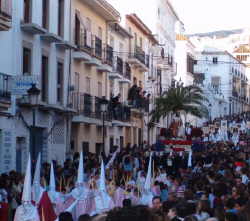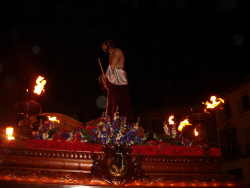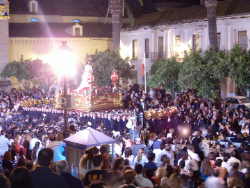|
Semana SantaA week during which joviality and religious solemnity run hand in handThe origins of Semana Santa can be traced back as far as the 15th century, when following their defeat of the Muslim dynasty at Granada, the Catholic Monarchs Ferdinand and Isobel, used the celebrations as a way to educate and galvanize the Catholic unity of the masses. Today the Catholic faith still forms an important backbone to modern Spanish culture and so the vast majority of the population observe and participate in the Semana Santa (Holy Week) celebrations.
The best places to experience Semana Santa is either in the city of Malaga where the largest celebrations take place or locally in the town of Velez-Malaga.
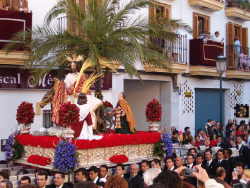
Here in Velez-Malaga the brotherhoods are made up of local groups such as the guild of tradesmen and each one is devoted to a patron being either an incarnation of the Virgin Mary or Jesus Christ. Each of the brotherhood's headquarters or Cofradias is home to a larger than life statue honoring their patron. On the patron's feast days and during Semana Santa the statues are then paraded through the local town’s streets carried high on tronos or huge thrones. Only during Semana Santa are all the statues paraded together on a traditional route through town dating back hundreds of years. The week begins with each statue being paraded individually from the cofradia to a temporary home, a large tented temple erected near to a church or a traditional point on the route. During the early part of the week members of the particular brotherhood will set about dressing and decorating their statue. There is definitely a sense of competition between the various associations as to who can make their statue appear the most splendid.
There is something military in the way the statue carriers are called to attention by the striking of a bell at the head of the throne, now adorned with flowers and candles. All this decoration adds to the considerable weight that its carriers bear as like a tug-of-war team, they take the strain and raise the throne from the ground. At the second strike of the bell the bearers in some cases up to 200 men, begin to sway and move as the statue starts on its slow journey.
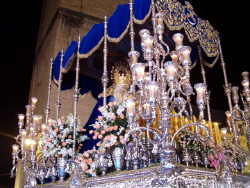
As they depart the rhythmic beat of drums helps to keep the bearers in time. The drums form part of the uniformed marching band which accompanies each statue along the route adding to the military feel to the proceedings. Along with the band are fellow members of the brotherhood, the more senior members carrying staffs, wafting incense-burning censers and other religious artifacts. Also present are the Penitents, traditionally dressed in long robes and pointed hoods to conceal their identity as they seek absolution for their sins.
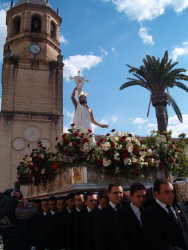
It will take an average of 5 hours for each statue to complete its journey along the processional route and most of the crowd will patiently wait to see each one pass. As you may have worked out this means that the streets will remain alive with the sights, sounds and smells of the procession until well after 3 a.m.
Click for more information on Semana Santa Velez Malaga 2007. If you would like to stay in Velez-Malaga and experience the spectacle for yourself, click onto our accommodation page for more information on holiday rentals in the area. Coming to Velez-Malaga? Then why not visit the Semana Santa Museum. For more information on fiestas in the region please see our fiestas page.
|




